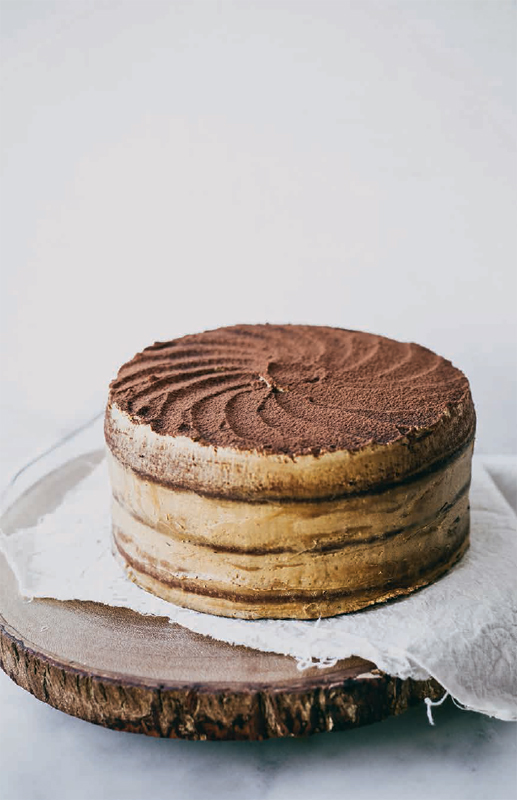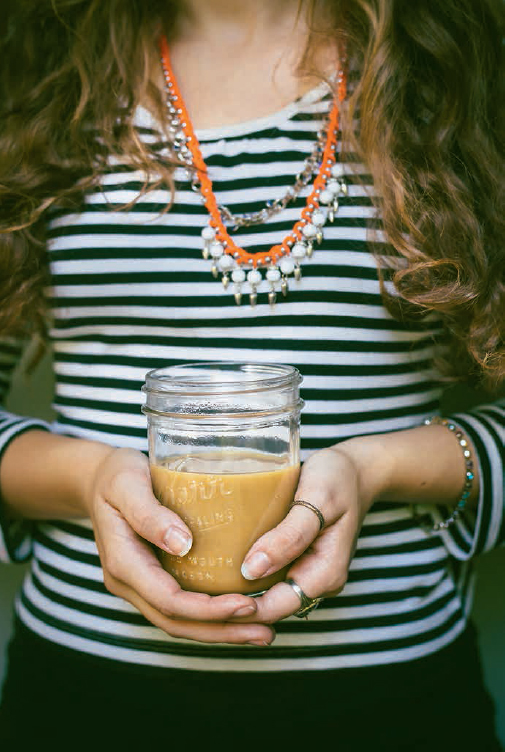
[ SERVES 9–12 ]
I face a constant dilemma when it comes to talking about coffee cake. Are you telling me about a coffee-flavoured cake, or the streusel-topped cake, popular in America, that is eaten with a cup of coffee? After visiting my grammy in Boston, my mum brought back a recipe from one of her friends. It was a recipe for Secret Sour Cream Coffeecake. I asked mum about the lack of coffee and she laughed at me but eventually explained the difference. That’s why I’ve called this Cappuccino Cake, so you won’t flick to the page expecting a fruity brunch cake. Instead you’ll know I’m talking pure coffee flavour, and this cake delivers. The sponge and buttercream are unashamedly infused with it, then it’s topped with coffee-whipped cream and dusted with cocoa powder, so it even looks vaguely cappuccino-like!
Ingredients
250 g (9 oz/2¼ cups) plain (all-purpose) flour
3 tsp baking powder
50 g (2 oz/½ cup) ground almonds
220 g (7¾ oz/1 cup) granulated sugar
½ tsp salt
110 g (3¼ oz/½ cup) unsalted butter
3 tbsp instant coffee granules
80 ml (3 fl oz/⅓ cup) milk
3 eggs
Frosting and Filling
2 tbsp instant coffee granules
125 ml (4 fl oz/½ cup) whipping cream
360 g (12 oz/3 cups) icing (confectioners’) sugar, plus 2 tbsp
110 g (3¾ oz/½ cup) unsalted butter, cut into small cubes
2 tbsp cocoa powder
Preparation
Preheat the oven to 180°C (350°F/Gas 4). Line, grease and flour three 20 cm (8 in) cake tins, as shown on How to Line, Grease and Flour Cake Tins.
In a large bowl, mix together the flour, baking powder, ground almonds, sugar and salt. Using your fingers, rub the butter into the dry ingredients until no large chunks of butter remain.
Dissolve the coffee in 80 ml (3 fl oz/⅓ cup) hot water and pour into the flour mixture, along with the milk and eggs. Mix together using a wooden spoon or a hand-held electric beater.
Divide the batter between the lined cake tins and bake for 20–25 minutes until the cake springs back when poked with a finger. Let the cakes cool in their tins for 10 minutes, then turn out onto a wire rack. Remove the baking parchment and turn the cakes right-side up. Leave to cool completely before using a serrated knife to level any domed cakes.
To make the filling and frosting, combine 2 tablespoons of boiling water and the instant coffee in a small bowl. In a large bowl, whisk the cream until it just starts to thicken. Add the 2 tablespoons of icing sugar and 1 tablespoon of the dissolved coffee. Continue to whisk until it forms soft peaks (if it starts to look grainy, immediately add 2 tablespoons of extra whipping cream and gently stir it in). Chill in the fridge while you make the buttercream.
Make the coffee buttercream by creaming the butter, remaining dissolved coffee and the icing sugar together in a separate bowl until smooth. It should be the consistency of cream cheese so add a splash of milk if it seems too thick.
To assemble, place 1 cooled cake (cut-side down, if levelled) on a cake stand or large platter. Place one-third of the buttercream on top of the cake and use a spoon or butter knife to spread it over the surface of the cake, stopping just shy of the edge. Top with a second cake (again, cut-side down) and press down lightly so that the buttercream is pushed to the edge. As before, cover with buttercream and then top with the third cake (cut-side down).
Use the remaining buttercream to very thinly frost the side of the cake (this is known as a crumb coating). Use the coffee-whipped cream to frost the top of the cake. To create the effect shown in the photograph, use a palette knife to create C-shapes in the whipped cream, starting at the top of the cake and moving towards the centre. Do this all along the edge of the cake until you’ve covered the entire surface, then dust with cocoa powder. The cake will keep in the fridge for a couple of days; bring it to room temperature before serving.

